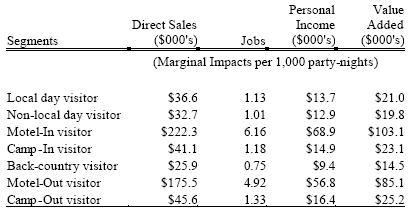Impacts of Visitor Spending on Local Economy:
Crater Lake National Park, 2001
Summary and Discussion
Visitors to Crater Lake NP spent $30.7 million within a 100-mile radius of the park in 2001. The total economic impact of visitor spending was $25.8 million in direct sales, $8.6 million in personal income, $13.0 million in direct value added and 733 jobs. With multiplier effects, created by the re-circulation of money spent by tourists, visitor spending generated a total of $34.3 million in local sales, and an associated $11.5 million in personal income, $18.3 million in value added and 863 jobs. Sectors receiving the greatest direct benefit from park visitors were lodging ($10.8 million in direct sales) and restaurants ($6.6 million).
The park’s relative importance to the local economy can be identified by comparing these figures with local tourism and economic statistics. Total lodging sales in East Douglas, Jackson and Klamath County was $60 million and total visitor spending was around $496 million in 2000 (Dean Runyan Associates, 2002). Crater Lake NP visitors contributed around $30.7 million in overall spending and $10.8 million in lodging sales. This spending accounts for 6% of total tourism spending and 18% of total lodging sales in the three county region.
The overall MGM2 economic impact estimates provide a quantitative picture of the role the park plays in the region’s economy. An understanding of the park’s economic significance is helpful in garnering support among local partners to help preserve the park and also to better serve both the visitor and the surrounding communities. The MGM2 model can also be used to evaluate alternative management, development and marketing decisions. For example, the marginal economic impacts of particular visitor segments can be useful for evaluating particular marketing and development policies both within and outside the park. Table 8 shows the changes in sales, jobs, income and valued added associated with an increase or decrease of one thousand additional party-nights by each visitor segment.
To evaluate the regional economic impacts of adding an additional 10 rooms to an area hotel, for example, first compute the change in party nights – 10 rooms occupied 100 nights yearly yields 1,000 extra party nights. Applying the marginal impacts for the “Motel-out” segment in Table 8, generates an additional $175,500 dollars in direct sales in the region,
Table 8. Direct impacts of an additional 1,000 party nights by lodging segments, Crater Lake NP, 2001
Impacts of Visitor Spending on Local Economy: Crater Lake National Park, 2001 Page 15$56,800 in personal income, $85,100 in value added and 5 direct jobs. The impact of this alternative could be compared to others such as expanding campsites, a marketing campaign to increase day trips, etc.
The impacts presented in this report document the economic significance of 457,000 recreation visits to Crater Lake NP in 2001. The impacts will vary from year to year with changes in prices, visitor volumes, the mix of visitors attracted, and other changes in the park and surrounding communities. The MGM2 model has built- in procedures to price adjust spending averages over time, so updated figures may be obtained fairly easily, if there are not significant changes in visitor use and spending patterns. In the absence of significant structural changes in the local economy, multipliers will be quite stable. So the primary input for updating the estimates are visit estimates, which must take into account any changes in the mix of visitors or their length of stay in the area.
Suggested research to further refine the spending and impact estimates would include (1) a survey of off-season park visitors to refine the annual segment shares, party sizes, length of stay and spending profile; (2) general surveys of visitors to the region in cooperation with local tourism organizations to understand the park’s share of the region’s travel market and visitor patterns of use both inside and outside the park.
***previous*** — ***next***


